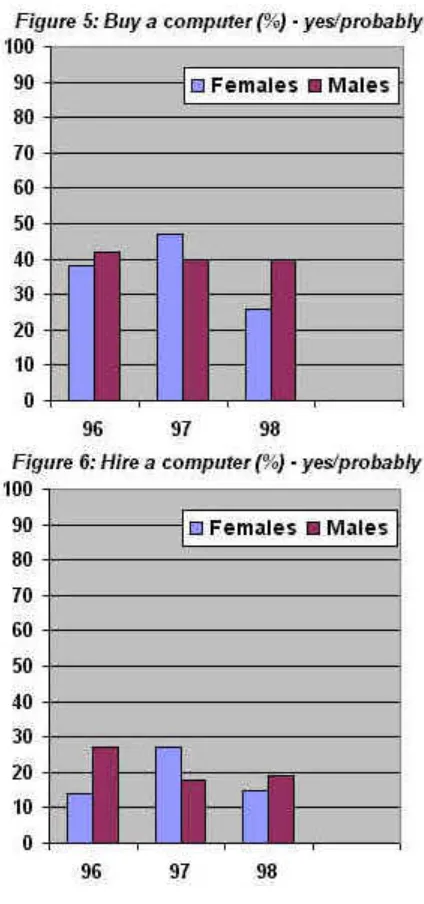Aspects of Computer Use by Chemistry Students in Their
Final Year at School
This article was first published in the CTI Centre for Chemistry journal Software Reviews Volume 19, May 1999.
Roger Gladwin
CTI Centre for Chemistry, University of Liverpool, United Kingdom
This report is an analysis of responses to a questionnaire given to freshers arriving at the Chemistry Department of Liverpool University to determine their previous use of computers, their perceptions of their competence, confidence and ability to benefit from computers and the importance they attach to possessing a computer and being trained in the use of computers. The questionnaire has been used between 1990 and 1998; the results presented herein include results from the surveys between 1996 and 1998. The 1990 data have been previously presented in Software Reviews Volume 3, issued February 1991; the 1992 data can be found in Volume 7, dated January 1993; the 1993 data are in Volume 9, dated March 1994; the 1994 data in Volume 11, dated May 1995; and the 1995 data in Volume 12, dated October 1995. The data for 1996 and 1997 have been reported, in part, in a comparison of results for a cohort of students who were freshers in 1996 and who returned to university in 1997. This report has been published on our web site at http://www.liv.ac.uk/ctichem/surv9697.html. The survey form asks students about their use of computers in their last year at school, their perceptions of their computing skills, confidence, expectations of ability and interest in using computers, whether or not they own or have access to a computer and their attitudes to buying or hiring a computer and to training (even if that were given out of hours). The form also allows for comments. The 1996 survey data is based upon returns from 60 males and 32 females, the 1997 data on 52 males and 34 females, the 1998 data on 53 males and 27 females.
Computer usage
Students were considered to be frequent users of computers if they had used them on a daily or weekly basis. Figure 1 shows small increases in frequent users across the survey period with males making more frequent use than females. In most cases the principal use made of
Computing skills
Data were collected for perceptions of skills relating to word processing, use of drawing/painting programs, database searching/creation, use of spreadsheets and using email/web. In all cases, the results show a perception of better skills for word processing and worse skills for Internet
activities. The results for general skills are shown in Figures 2 and 3. For Figure 2 the scores for those considering themselves to be expert or good are combined and in Figure 3 the results are a combination of the scores for perceptions of poor/no skills. There has been again a slow increase in those considering themselves expert or good with computers and in all cases the results for males are higher than those for females. Encouragingly, the trend for those considering
Computer ownership
Computer training
Confidence, expectations of ability and interest
Open comments
Increased computer literacy (greater than 50% of responses for all three survey sets), helping with coursework and improved job prospects were the main drivers for wanting to use computers.
Conclusions
Regular use of computers prior to university entry is on the increase and is particularly prevalent in males. Computer ownership is also increasing. This may explain why, those students
considering their computing skills to be poor are reducing and those who consider themselves to be expert or good with computers is increasing to about the 50% mark. However, most students still see advantages in further computer training.
Males make more frequent use of computers than females and perhaps this is why they are more confident in their use and have greater expectations of their ability when compared with the females in each cohort.
References
Gladwin, R. (1991) A survey of computer-literacy and perceptions of computers for recent school leavers. Software Reviews, 3, 5-11.
Gladwin, R. (1993) Aspects of computer use by chemistry students in their final year at school. Software Reviews, 7, 5-8.
Gladwin, R. (1994) Aspects of computer use by chemistry students in their final year at school. Software Reviews, 9, 5-8.
Gladwin, R. (1995) Aspects of computer use by chemistry students in their final year at school. Software Reviews, 11, 5-8.
Software Reviews, 12, 8-11.
Gladwin, R. (1998) Student Survey - Use of computers, perceptions of ability and attitudes to computers, computer ownership and training. http://www.liv.ac.uk/ctichem/surv9697.html
Roger Gladwin
CTI Centre for Chemistry Donnan Laboratories University of Liverpool Liverpool
L69 7ZD
United Kingdom
ctichem@liverpool.ac.uk
